Monday, October 18, 2010
Sunday, October 17, 2010
Wednesday, September 29, 2010
Impacted Iron wire in the Oesophagus of Buffalo calf: Case report
.jpg) Figure 3: Operative photograph showing retrieval of iron wire.
Figure 3: Operative photograph showing retrieval of iron wire..jpg) Figure 4: Iron wire removed by Oesophagotomy
Figure 4: Iron wire removed by Oesophagotomy.jpg) Figure 2: Showing oesophageal perforation and retrieval of wire from external side
Figure 2: Showing oesophageal perforation and retrieval of wire from external side.jpg) Figure 1: Lateral view- Wire of iron out side of the mouth
Figure 1: Lateral view- Wire of iron out side of the mouthAbstract
Objective: To report a rare case of impacted foreign body (Iron wire) in the oesophagus and review the literature.
Case Report: This is a case report of impacted foreign body (Iron wire) in the oesophagus. The wire could be seen on out side of the mouth in the buffalo calf. The owner and other peoples has tried to remove the wire by force and approaching manually through mouth has not succeded to remove the iron wire. Case is later on referred to Hassanian Veterinary Hospital Mircolony Tandojam,
Conclusion: Foreign body ingestion is a common problem. Early removal of foreign bodies must be considered to reduce the risk of complications. Impacted iron wire in buffalo calf in the oesophagus which was removed by oesophagotomy is an unusual presentation. To the best of my knowledge this is the first case report from
Introduction
Foreign body ingestion is a common problem 1 . Most common foreign bodies in pediatric age group are coins 2,3but meat bone, marbles, safety pins, button, batteries and screws are also reported. Adhikari et al study also showed coins and denture as a common foreign body in adults 4 . Foreign body ingestion is a common occurrence and carries significant morbidity and mortality. Sharp Foreign Bodies is frequently associated with serious complications 4 . If they are not removed at the earliest, they can cause erosion, perforation, abscess or mediastinitis 3 . Early removal of these Foreign Bodies must be considered to reduce the risk of complication 4 . I report a case of impacted foreign body (ron wire) in the oesophagus of buffalo calf. To the best of my knowledge this is the first case report from
Case Report
A one month old female buffalo calf presented to
With the diagnosis of foreign body (iron wire) in oesophagus, calf was operated under general anesthesia. The wire of the iron was impacted on lateral wall of oesophagus and wire could not be removed. After 5 hours the calf underwent oesophagotomy and retrieval of the wire via external approach.
Small incision was performed by pushing the wire and approaching from external side. The incision was closed in layers and dressing applied. Fig. 4 showed the iron wire of 18 inches long after removal by oesophagotomy.Post operatively intramuscular antibiotics were continued for 2 days and milk feeding was given in morning and evening. suture was removed on 7 th postoperative days. The calf was discharged on the same day surgery without any problem.
Conclusion
Impacted iron wire in the oesophagus which was removed by oesophagotomy is an unusual presentation. To prevent accidental ingestion, dentures should be made to fit properly and damaged or malfitting dentures should be discarded and replaced. Patients should be strongly advised against wearing them in bed.
References
1. Shivakumar AM, Naik AS, Prashanth KB, Yogesh BS, Hongal GF. Foreign body in upper digestive tract. Indian J Pediatr 2004; 71:689-693. (s)
2. Yang CY. The management of ingested foreign bodies in the upper digestive tract: a retrospective study of 49 cases.
3. Guitron A, Adalid R, Huerta F, Macias M, Sanchez Navarrete M, Nares J. Extraction of foreign bodies in the esophagus: Experience in 215 cases. Rev Gastroenterol Mex 1996; 61:19-26. (s)
4. Prakash Adhikari, Bikash L. Shrestha, D.K. Baskota, Bimal.K.Sinha.Accidental foreign body ingestion: analysis of 163 cases. Int Archieves of Otorhinolaryngol 2007; 11(3):267-0. (s)
Monday, September 27, 2010
Sunday, September 26, 2010
Saturday, September 25, 2010
Thursday, September 23, 2010
Tuesday, September 21, 2010
Sunday, September 19, 2010
Saturday, April 24, 2010
World Veterinarians' Day
Monday, March 22, 2010
Tuesday, February 23, 2010
FIBROADENOMA MAMMARY TUMOR IN A SAMOYED

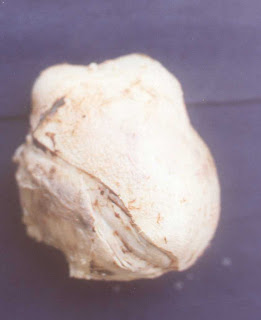
Mammary tumors are most common tumors in female dogs. The greatest frequency of mammary tumors found in poodles , Boston terriers, fox terriers, Airedale terriers, dachshunds, Great pyreness, Samoyeds, keeshonden and sporting breeds (pointers, retrievers, setters, spaniels). In dogs, benign tumours are usually classified as benign mixed tumours (fibroadenoma, adenomas or benign mesenchymal tumors). Approximately 25% to 50% of canine mammary tumors are malignant (Baba et al, 1985, Ogilvie and Moore, 1995). Malignant mammary tumors spread via lymphatic and blood vessels to the regional lymph nodes and lungs. Other less common metastatic sites include adrenal glands, kidneys, heart, liver, bone, brain and skin. The mixed mammary tumors are the most commonly identified neoplasm in the bitch (Dorn et al, 1968, Moulton et al, 1970) Malignant tumors frequently arise from benign masses (Flowers et al, 1974). The cause of mammary gland neoplasia is unknown. However, many are hormone dependant and most can be prevented, if ovariohysterectomy is performed before one year of age. The risk of mammary tumors for dogs spayed before first estrus is 0.05%. This risk increase to 8% after one estrus cycle and 26% after the second estrus (Ogilvie and Moore, 1995) Estrogen or progesterone receptors are found in 50% or more of canine mammary carcinomas and 70% of benign canine mammary tumors (Sartin et al, 1992). Mammary neoplasm may be solitary or multiple. The most common site for canine mammary tumors is the caudal mammary masses may varies from microscopic to grossly visible of various sizes (2 mm to 8 cm). Masses may be sessile of pedunculated, solid or cystic and uncerated or covered with skin and hair.
HISTORY:
A 10 months Samoyed bitch was presented because of a solid large lump involving second last caudal left (4th) mammary gland. The owners had noticed small nodule since the dog was of 2 months old.
PHYSICAL EXAMINATION:
All mammary glands were normal except left caudal 4th mammary gland. Solid consistency and over growth of tissues were observed on physical examination, palpation and aspiration. Benign tumor was suspected on physical appearance. Tissues from lump were obtained with the help of biopsy punch for further investigation and histological examination.
ULTRASONOOGRAPHY:
Ultrasonography was performed to identify the demarcation or abdominal involvement if any. Solid ball like structure was observed under ultrasonography with clear demarcation from abdominal wall.
DIAGNOSIS:
Benign tumor was suspected on physical examination and histologically, fibroadenoma was identified.
SURGICAL PROCEDURE:
Dog was premedicated with acepromazine at the dose rate of 0.05 mg/kg. General anaesthesia was administered with thiopental sodium 5% solution at the dose rate of 10 mg/kg. Animal was placed in dorsal recumbency with the thoracic limbs fixed cranially and the pelvic limbs fixed caudally in a relaxed position. The entire abdomen caudal thorax and inguinal areas were clipped and prepared for aseptic surgery. An elliptical incision around the involved mammary gland 1 cm from the tumor was made. Incision was continued through subcutaneous tissues to the fascia of the external abdominal wall superficial hemorrhage was controlled with swabbing, hemostats or ligation. An en bloc excision was performed by elevating one edge of the incision and dissecting subcutaneous tissue from pectoral and rectus fascia using smooth gliding motion of scissors. Traction was given on the elevated skin segment to facilitate dissection. The caudal superficial epigastric vessel was ligated and the superficial inguinally lymph node excised. A 3 inches circular ball like mass weighing 1500 gms was removed . All glandular tissue inguinal fat pad, abdominal musculature and a portion of the abdominal wall were removed. Walking sutures were used to undermine the wound edges and advance skin toward the center of the defect. Subcuticular sutures were used to appose skin edges. A series of horizontal mattress sutures were placed in the entire length of the wound. A second line of fine, simple interrupted sutures was used to appose the primary wound margins.
POSTOPERATIVE CARE AND ASSESSMENT:
An abdominal bandage was used to support the wound, compress dead space and absorb fluid. Bandage was changed daily for the first 3 days. The wound was inspected for inflammation, swelling, drainage, seroma, dehiscence etc. Bandages and mattress suture were removed after 4 days and remaining interrupted sutures were removed 12 days after surgery. Animal was normal and healthy after six months.
Monday, February 22, 2010
TREATMENT OF HIND LIMB FRACTURE IN DEER

The deer are very beautiful animals. They are famous for their speed, grace and good look. Deer are the ruminant mammals forming the family Cervidae. They include for example Moose, Red Deer, Reindeer, Roe and Chital. Animals from related families within the order Artiodactyla (even-toed ungulates) are often also considered to be deer – these include muntjac and water deer. Male (and a few female) deer of all species (except the Chinese Water deer who only have short tusks instead) grow and shed new antlers each year – in this they differ from permanently horned animals such as antelope – these are in the same order as deer and may bear a superficial resemblance. The musk deer of Asia and Water Chevrotain (or Mouse Deer) of tropical African and Asian forests are not usually regarded as true deer and form their own families, Moschidae and Tragulidae, respectively. The gazelle is hunted for the sake of its delicious flesh, fat and beautiful hide. Many people and professional hunters take keen interest in antelope hunt its delicious flesh, fat and beautiful hide. Many people and professional hunters take keen interest in antelope hunting. Now, people in Pakistan capture fawns and antelopes to keep as fancy/pet animals in houses. Unfortunately, people do not understand surveillance and management of these wild animals. Therefore mostly fractures, damages to the skin and other parts of the body of the animal occur during capture and transport. Fracture of the forelimbs, hind limbs and of the pelvis are relatively common in antelopes, when predators attack them.
Case History:
A 2 years old zoo female deer was presented having fractured hind leg.
DIAGNOSIS:
Clinical examination revealed swelling, pain and crepitus sound s on palpation in left hind leg. Whereas, left forelimb’s skin was damaged. Deer was standing on her leg with laming gait. There was a damage to the skin and bone in hind leg.
TREATMENT:
Treatment was basd on conservative management. Deer was kept in rest, activity was limited and measures were taken to ensure regular urination and defaecation. Animal was restrained and placed laterally to make plastering with Gypsona (plaster of Paris) of hind leg.
TREATMENT OF COMPOUND FRACTURE IN HIND LIMB OF GAZELLE
The antelopes are very beautiful animals. They are famous for their speed, grace and good look. They are deer like ruminants and belong to family bovidae. The antelopes are divided into nine separate groups. The Gazelle is one of the largest group of antelopes. The gazelle is most attractive and graceful animal and lives in desert area of Thar, Sindh, Pakistan. It is a creature of the burning deserts, treeless plains and sandy wastes. The gazelle is hunted for the sake of its delicious flesh, fat and beautiful hide. Many people and professional hunters take keen interest in antelope hunt its delicious flesh, fat and beautiful hide. Many people and professional hunters take keen interest in antelope hunting. Now, people in Pakistan capture fawns and antelopes to keep as fancy/pet animals in houses. Unfortunately, people do not understand surveillance and management of these wild animals. Therefore mostly fractures, damages to the skin and other parts of the body of the animal occur during capture and transport. Fracture of the forelimbs, hind limbs and of the pelvis are relatively common in antelopes, when predators attack them.
Case History:
A 2 years old pet female Gazelle was presented having damaged forelimbs and fractured hind leg.
DIAGNOSIS:
Clinical examination revealed swelling, pain and crepitus sound s on palpation in left hind leg. Whereas, left forelimb’s skin was damaged. Antelope was supported to stand on her hind legs then she was unable to bear weight on left leg and showed lameness. There was a damage to the skin and other part of the body. Fracture in the hind leg was diagnosed by latero-medial radiograph obtained for the assessment of extent of damage in the hind leg.
TREATMENT:
Treatment was divided into 2 planes i.e. conservative management and surgical intervention. Conservative approach was taken for left forelimb. Antelope was kept in rest, activity was limited and measures were taken to ensure regular urination and defaecation.
Surgical treatment: Animal was restrained and placed laterally to make plastering of hind leg.
Prognosis:
Radiographs were taken 3 weeks after plaster to assess healing. Prognosis was excellent and antelope returned to its normal functions.
Tuesday, February 16, 2010
Cessarian Section in Sheep
Sunday, February 14, 2010
SAVE THE AILING LIONESS IN ZOOLOGICAL GARDEN, RANI BAGH HYDERABAD, PAKISTAN

Welcome back!
This case reminded me ten years ago story of the same type of case in the Zoological Garden, Hyderabad. When, twenty years old ailing lioness “Rani” died in the same Zoo due to ignorance. She had a chronic otitis externa complain due to maggots. She was also injured few days before death in fighting to her husband in their cage as reported by authorities. Veterinarians had performed post-mortem which did not reveal any other problem in lioness. The lioness had given birth to six young ones in her life in the Zoological Garden, Hyderabad. Two of them were lived in the zoo and others were replaced in exchange of other animals. Unfortunately, she did not received the treatment due lack of facililties like anaesthetic gun and experts. Today is also same position, anaesthetic gun and surgical instruments are not avialble in the zoo. I am afraid that Once again same story may not be repeated. Therefore, it is requested to higher authorities (DCO and District Nazim, Hyderabad specially and other authorities particularly), public, vets and NGO’s to show their interest and save the life of the ailing lioness. Watch the video for risky method and technique applied to treat the lioness.
Friday, February 12, 2010
Tail Docking
Here is again a blog post with conflict on its discussion. Tail Docking is a process of Amputation of Tail. It is mostly included in the Cosmetic Surgeries Category, But there may be also some pathological reasons.
In many Countries these surgeries are banned, But owners still want these surgeries to be conducted, because these are conducted to compete there animals in show competitions. The surgery is also conducted to avoid bite by the animal in Dogs fights.
Procedure:
Animal is anaesthetized after sedation as aroutine then site is prepared by clipping hairs from the tail, antiseptic is applied, and then tail is amputated from the inter vertebral space. A V-Shaped incision is given with slightly pushing the skin towards the base of tail. So that some skin is available to cover the vertebrae. The exposed ends of skin are sutured, Tincture is applied, and then wound is covered with suitable bandage material to avoid flies and contaminations.
The whole process is as under:
Tuesday, February 9, 2010
Pregnancy Diagnosis through Ultra-Sonography in buffalo
Sunday, February 7, 2010
Declawing Techniques
Friday, February 5, 2010
Management of Incisional Hernia
Suzy was operated to Neuter, But unfortunately, she developed Incisional Hernia, A pouch ddeveloped at her belly, and this increased continuously. Hernial Pouch, Contents and Ring was discovered by direct palpation. To treat her problem, she was operated.
She was Anesthetized, and then incision was given, Mesentry was found as Hernial content. Contents were pushed back, ring was closed, then she was sutured back.
The outline video is available here, with a continuous, and very clear demonstration by Dr. Allah Bux Memon. Hope this will give you a perfect idea that how to treat and manage a Hernia, specially Incisional Hernia.
Tuesday, February 2, 2010
Management of dystocia during lambing

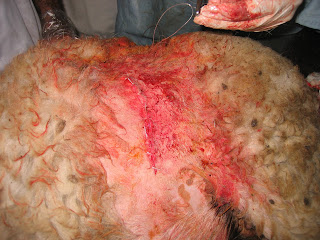




Livestock play an important role in Pakistan and generates about 30 to 40 percent income by rearing cattle, Kundhi buffaloes, sheep and goats. Livestock is a potential economic source for 30-50 million of total rural population of Pakistan. There are about 27.3, 29.6, 53.8, and 26.5 million heads of Kundhi buffalos, cattle, goat and sheep respectively. Livestock contributes about 50% of agricultural value added and 11 percent to GDP. Small ruminants include sheep (24.2 million) and goats (49.1 million). There are about twenty eight (28) or even more sheep breeds which are classified into two groups viz; thin-tailed and fat-tailed sheep (Table 3). Thin tail sheep are generally found in irrigated areas and fat tail breeds in arid rangelands and mountainous areas of Sindh, NWFP and Azad Kahmir. According to another FAO survey nineteen sheep breeds are classified under the thin tail category while twenty-eight sheep breeds come under the fat tailed sheep. However, the total sheep breeds and their distribution in different province in the country are presented in Table 4. Usually sheep are kept for wool and mutton production. The wool is of coarse quality and is mostly used in the local carpel industry. Local sheep breeds generally breed once a year and rarely produce twins. Annual lambing rate is about 80 % on overall basis.
Table: Important Sheep Breeds of Pakistan.
Thin Tail Sheep Fat Tail Sheep
Bakkarwal Balkhi
Buchi Bibrik
Cholistani Dumbi
Damani Gojal
Kacchi Harnai
Kaghani Hashtnagri
Kail Kohai Ghizer
Kali Michni
Kajli Pahari
Kooka Rakhshani
Lohi Salt Range
Poonchi Tirahi
Sipli Waziri
Thalli -
CASE HISTORY:
A two years old 25 kg Kuka sheep was referred by Department of Animal Reproduction to the Department of Surgery and Obstetrics Clinic with a complain of dystocia on 08-01-2010. The sheep was presented with a foetus having two fore legs expelled out through vulva. Physical examination revealed that the head is deviated to ventral direction in the pelvic cavity. Clinically sheep was exhausted with 1030F. Persistent straining had started 12 hours before examination to expel out fetus. Dr. Inayatullah Kaka has pulled out forelegs of the fetus through vulva but head is deviated to pelvic cavity. She was unable to give birth to the fetus. Owner has requested for c-section.
OPERATIVE TECHNIQUES:
Sheep hairs from site were clipped and high epidural and L-shaped local anaesthesia with xylocaine was performed. Animal was placed on lateral recumbency on floor. Students have restrained the sheep from hind and forelegs. The left flank site was prepared for aseptic surgery as per routine. The incision was performed in the left flank area, where the muscular layers of externus oblique muscle, internus oblique muscle and transverse muscles were opened with blunt dissection and separated. After parietal peritoneum was opened and cranial portion of the uterus was exteriorized. Incision was given in the longitudinal line on dorsal surface of uterine wall. The posterior limbs of foetuses were grasped and one dead fetus was removed along with placenta. Uterine passaries were placed in the uterus. Incision of uterus was closed with Connell suture technique. All the blood clots were removed from the uterus before it was replaced into abdominal cavity in it’s normal position. Closure of abdominal wall was carried out in three layers. Peritoneum was closed with simple interrupted sutures using 2/0 chromic catgut. The muscular and subcutaneous layers were apposed with simple continuous sutures using 2/0 chromic catgut. Skin incision was closed with simple interrupted suture technique using 1/0 nylon.
Post-oprative care:
Inj: Trioxyl LA 5 ml and Inj: Phenylbutazone 3 ml was administered Intra-muscularly for three days post operatively. On follow up observation defaecation, urination, rectal temperature, pulse rate, respiratory rate, intake water, and feed returned to normal within 5 hours.
Sunday, January 31, 2010
Dogs and cats needs Government and Public attention and care in Pakistan

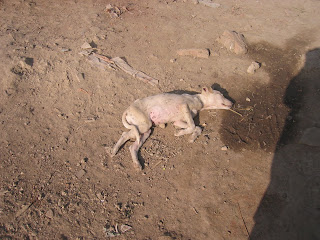


Stop murdering the stray dogs and cats
Please friends from all countries , what we want is to convince the Pakistan authorities to work with Young Surgeons group, Bright veterinarian group and Veterinary Surgeon Club, Faculty of Animal Husbandry and Veterinary Sciences, Sindh Agriculture University Tandojam for Animal Welfare, control of over population of stray dogs and cats and to start immediately a mass sterilization of the stray dogs and cats. Through spaying and neutering of stray animals, public education and re-homing, our mission is to ensure that every dog in Pakistan is eventually given the chance of a life where it is cared for and treated with kindness and understanding to ensure a safe and happy future. We rely solely on volunteers and donations from animal welfare supporters to continue our work. If you would like to get involved please DONATE, ADOPT A PET and VOLUNTEER. We also sell immunized and neutrilized pure breed pets to arrange shelter, food, medicines and surgical material for these stray dogs. you can buy them. With your help we will save stray dogs and cats.
Thursday, January 28, 2010
DECLAWING IN CAT (demonstration in class for 3rd Prof. D.V.M. students)









Although each veterinarian may have his own technique for declawing but generally speaking there are two basic techniques which are commonly employed. One is trimming (either Resco or whites) and other is to remove entire third phalanx (Foster and Fowler, 1971 and Silverhorn and Taskulski 1972). With nail trimmer technique, if the corium of the claw is not completely removed, regrowth of a deformed nail will become evident in 3 to 6 months or even later. Since the regrowth occurs beneath the skin. It does not become evident until lameness, swelling and drainange tracts are noticed. To correct this it is necessary to remove a libral amount of skin and tissue from which the nail originated including the remnant of the third phalanx. The latter method has the advantages of removing the entirethird phalanx to make certain no regrowth of the nail occurs and it can be used on a large variety of animals such as dogs, lions, tigers and bears. By paying attention to the details of the anatomy of feline claw the considerable result of claw regrowth may be avoided.
ANATOMY OF DISTAL PHALANX:
The third phalanx of the cat is much like that of dog (Evan and Lahuta 1980) except that the cat claw is distinctly flattened and is retractile. Richard and Jenning (1963) stated that the proximal and base of the third phalanx forms a loose articulation with the second phalanx. The distal phalanx is made up of two main parts, the ungula process and the ungula crest. The ungula process is a curved cone shaped projection that extends distally into the claw. The ungula crest is an elevation that circumscribes the base of the third phalanx and forms a ridge and projects proximally over the distal end of the second phalanx. The ungula crest serves as an insertion for the deep digital flexor tendon on the volar surface of the third phalanx and for the insertion of the lateral and common digital extensor and extensors of the first and second digit muscles are located on the ungula crest of the third phalanx of the second digit. In addition to tendons that cross the joint, the cat has two strong dorsal elastic ligaments on each digit. These ligaments originate at the sides of the proximal end of the second phalanx and insert distally on the dorsal surface on the ungula crest. Their contraction results in the claws retraction. The flexing power of the deep digital flexor muscle can over come the elasticity of this ligament and allow the cat to extend its claws. A pair of collateral ligaments, one on the medial and the other on the lateral side of the joint crosses this joint. Being a true joint this distal articulation posses other typical joint structures. Including articular cartilage, synoval membrane and fibrous joint capsule. The basal germinal cells (stratum germinativum) of the claw extend proximally into the ungual crest encases the base of the nail. This area is important to consider when an onychectomy is performed. Regardless of surgical technique used to remove a cats claws, the dorsal aspect of the ungula crest must be removed in order to prevent regrowth. If the claw regrows, it most likely will be partial or misshapen this regrowth may not be evident for several weeks of even months following declawing when regrowth does occur excessive granulation tissue or a draining open wound which is subject to infection may precede eruption of the nail through the skin.
SURGICAL TECHNIQUES:
As previously described each veterinary surgeon ha his own technique and if the procedure is effective, there is no reason for change ( Michael 1983) It seems appropriate however to describe briefly a technique that has been used in past ten years and is working nicely at Department of Surgery and Obstetrics, Sindh Agriculture University Tandojam, Pakistan. Declawing is performed as routine demonstration exercise on healthy crossbred/local cat aged around 2 years, at department of Surgery and Obetrics. The male cat was anaesthetized with Inj: diazepalm, Inj: acepromazine and Inj: Ketamine hydrochloride intramuscularly to prolong the recovery period and to prevent excessive shaking of the feet. The paws are prepared by cleaning with a soap scrub followed by detol to remove dirt and debris around the nail. Clipping the hair is usually unnecessary. A conventional tourniquet is applied to the leg starting at above the paw and extending to the elbow on the foreleg and to the hock on the rear leg. The proximal end of the tourniquet is secured with an artery forceps. The claw to be removed is grasped with artery forceps. The cuticle is incised dorsally with a No. 15 blade surgical blade and the ungual crest becomes exposed. By downward manipulation of the claw, the articular space is identified. The surgical blade when directed into the space and following the surface of articular cartilage of the third digit, a cut is made up to and around the extensor process. This maneuver places the blade on the ventral surface of the extensor process just above the digitalpad. The blade is pulled fprward with care teken not to cut the digital pad, the flexor tendon. Blood vessels and other tissues are then severed. The excised digit is placed on an instrument tray and the wound is closed with simple Interrupted suture techniwue using chromic catgut 3/0 transversally through the skin of each digit. The next claw is removed in a similar manner. On completion of declawing the digits are counted to be certain that none have been left. After all the claws are removed, the paw foot is bandaged placing a sterile guaze spong over the paw and an application of adhesive tape over that to hold it in place. The adhesive tape is applied tightly enough to control seeping heamorrhage without interfering with circulation to the foot. The tourniquet is released. The adhesive tape is continued up the leg at least 7 to 8 cms above the paw to prevent the cat from shaking of the bandage. Intramuscular Inj: dioxil is administered routinely at the conclusion of operation and the bandage removed after 12 hours. The procedure was immaculately done as described has no complication what soever.
Wednesday, January 27, 2010
Young Surgeons Activities (Fly like a Eagle)
Monday, January 25, 2010
Management of Difficult Births at Kidding




Livestock play an important role in Pakistan and generates about 30 to 40 percent income by rearing cattle, Kundhi buffaloes, sheep and goats. Livestock is a potential economic source for 30-50 million of total rural population of Pakistan. There are about 27.3, 29.6, 53.8, and 26.5 million heads of Kundhi buffalos, cattle, goat and sheep respectively. Livestock contributes about 50% of agricultural value added and 11 percent to GDP. Meat and milk produced by Kundhi buffalos and cattle provides 70 % animal protein thus it is considered to be major source for human diet. It has been estimated that these animals produced 33.2 million tons of milk, 1.27 million tons of beef and 0.82 million tons of mutton during 2006-2007 (GOP-2007). Goat has a unique importance in livestock due to its exceptional qualities such as high fertility, short kidding interval, good mutton quality, milk and hairs. There are thirty nine breeds of goats in Pakistan out of which twelve belongs to Sindh province viz.; Kamori, Bari, Bugi Toori, Bujri, Chapper, Jattan, Kacchan, Kurri, Lohri, Pateri, Tapir, Teddy, and Thari. These are mostly grazed in mixed herds in which only one or two healthy bucks are kept to impregnate all goats. Mostly cross breeding between small, medium and large goats produce obstetrical problems and dystocia. Dystocia mostly occurs in goats due to small birth canal, uterine torsion, oversized fetus and incomplete relaxation of birth canal. Dystocia can be relieved by different obstetrical methods. The efficiency of the natural parturition forces can be increased by using tissue estrogens or by augmenting the expulsive power of uterus using oxytocin. The traction or vigorous manipulation may cause rupture of thin uterine wall in small size goats. Cesaerotomy is preferable technique for the delivery of fetus in these conditions.
CASE HISTORY:
A two years old 25 kg black colored goat was referred by Dr. Muhammad Uris Samo, Ex-Professor, Department of Animal Reproduction to the Hassanian Veterinary Clinic with a complain of dystocia at 8:30 p.m. on 23-01-2010. The goat was presented with a foetus having two fore legs expelled out through vulva. Physical examination revealed that the head is deviated to ventral direction in the pelvic cavity. Clinically goat was normal with 1030F. Persistent straining had started 12 hours before examination to expel out fetus. Owner has pulled out forelegs of the fetus through vulva but head is deviated to pelvic cavity. She was unable to give birth to the fetus. Owner was surprised on the recommendation of c-section. He was first time referred for c-section in goats. Whereas, surgeon has done one hundred twenty cases in goats, 4 cases in sheep, four cases in buffaloes, two cases in donkey, four cases in deer, eight cases in bitches, ten cases in cats etc. and all will be reported time to time on this web site.
OPERATIVE TECHNIQUES:
Goat hairs from site were clipped and high epidural and L-shaped local anaesthesia with xylocaine was administered. Animal was placed on lateral recumbency on floor. Owner has restrained the goat from hind and forelegs where Mr. Junied Keyani, students of Fourth Prof. D.V.M. and Mr. Hafiz Asif, Student of 3rd Prof. D.V.M. have assisted me. The left flank site was prepared for aseptic surgery as per routine. The incision was performed in the left flank area, where the muscular layers of externus oblique muscle, internus oblique muscle and transverse muscles were opened with blunt dissection and separated. After parietal peritoneum was opened and cranial portion of the uterus was exteriorized. Incision was given in the longitudinal line on dorsal surface of uterine wall. The posterior limbs of foetuses were grasped and two live fetuses were removed along with placenta. Uterine passaries were placed in the uterus. Incision of uterus was closed with Connell suture technique. All the blood clots were removed from the uterus before it was replaced into abdominal cavity in it’s normal position. Closure of abdominal wall was carried out in three layers. Peritoneum was closed with simple interrupted sutures using 2/0 chromic catgut. The muscular and subcutaneous layers were apposed with simple continuous sutures using 2/0 chromic catgut. Skin incision was closed with simple interrupted suture technique using 1/0 nylon.
Post-oprative care:
Inj: trioxyl LA 5 ml and Inj: Phenylbutazone 3 ml was administered Intra-muscularly for three days post operatively. On follow up observation defaecation, urination, rectal temperature, pulse rate, respiratory rate, intake water, and feed returned to normal within 5 hours.
Friday, January 15, 2010
Pregnancy Diagnosis
Thursday, January 14, 2010
Dehorning A Buffalo
Tuesday, January 12, 2010
Ventral Hernia [Hysterocele - Gravid] in a goat (Video Supported)
Continued..., Surgery Completed, Patient is on her legs and very much normal:
Ventral Hernia [Hysterocele - Gravid] in a goat Video Supprt
Surgical Treatment
Food was withheld for 24 h prior to surgery. Surgical repair was conducted by aseptically preparing the site of operation after intramuscularly tranquilizing the fractious animals with 2% xylazine hydrochloride (Rompun 2%; Bayer, Turkey) at a dose rate of 0.05 mg/kg. Circular infiltration anesthesia around the udder was done using 2% lidocaine (Norbrook Laboratories, UK) at a dose rate of 10 mg/kg. The animal was restrained in the dorsal or lateral recumbent position, according to the ease and for better exposure. An elliptical skin incision was performed and uterus exteriorized and tree kids were removed. Uterus was closed with 2/0 chromic catgut with Connell suture technique. The contents were reduced into the abdominal cavity through abdominal rupture. The abdominal rupture was exposed and closed with simple interrupted uing No. 2 chromic catgut (Ethicon, UK). The subcutaneous tissue was then sutured by catgut and the skin was closed with using silk suture. Penicillinstreptomycin at a dose rate of 30,000 IU/kg for the penicillin and 10mg/kg streptomycin was given for 5 days intramuscularly.
Monday, January 11, 2010
Ventral Hernia [Hysterocele - Gravid] in a goat

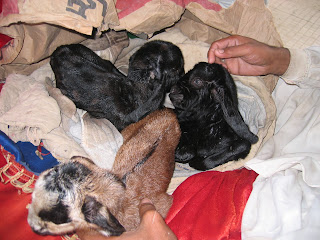
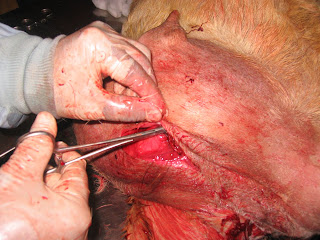
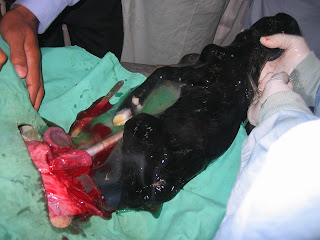
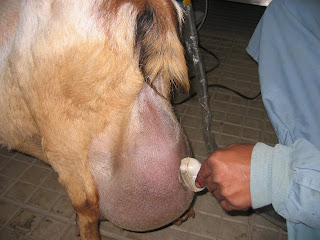

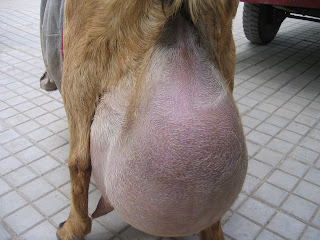
Surgical Treatment
Food was withheld for 24 h prior to surgery. Surgical repair was conducted by aseptically preparing the site of operation after intramuscularly tranquilizing the fractious animals with 2% xylazine hydrochloride (Rompun 2%; Bayer, Turkey) at a dose rate of 0.05 mg/kg. Circular infiltration anesthesia around the udder was done using 2% lidocaine (Norbrook Laboratories, UK) at a dose rate of 10 mg/kg. The animal was restrained in the dorsal or lateral recumbent position, according to the ease and for better exposure. An elliptical skin incision was performed and uterus exteriorized and tree kids were removed. Uterus was closed with 2/0 chromic catgut with Connell suture technique. The contents were reduced into the abdominal cavity through abdominal rupture. The abdominal rupture was exposed and closed with simple interrupted uing No. 2 chromic catgut (Ethicon, UK). The subcutaneous tissue was then sutured by catgut and the skin was closed with using silk suture. Penicillinstreptomycin at a dose rate of 30,000 IU/kg for the penicillin and 10mg/kg streptomycin was given for 5 days intramuscularly.
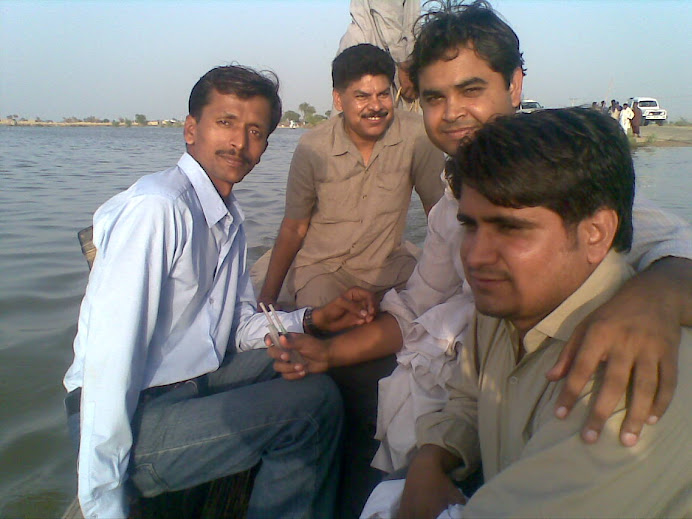.jpg)

